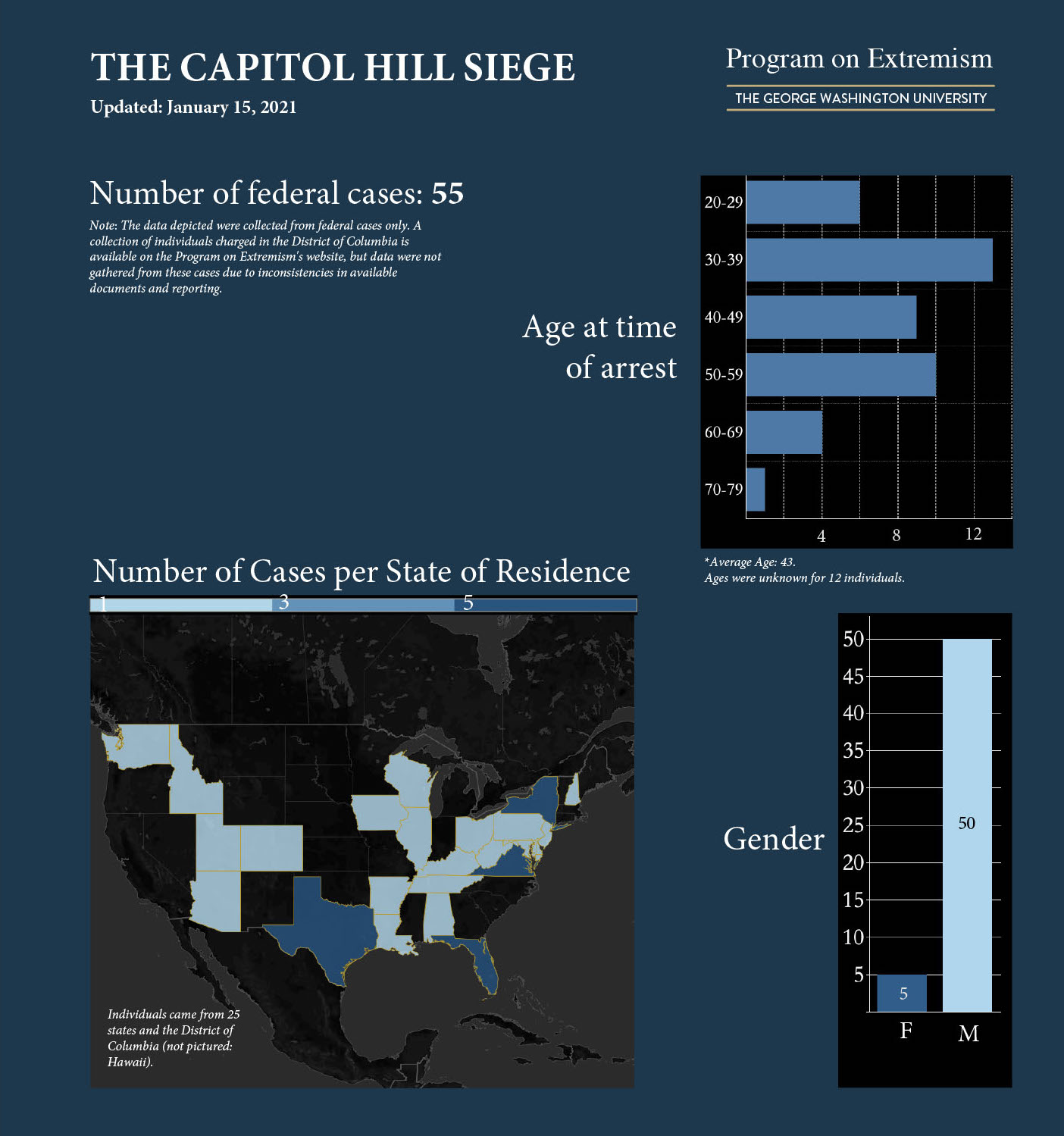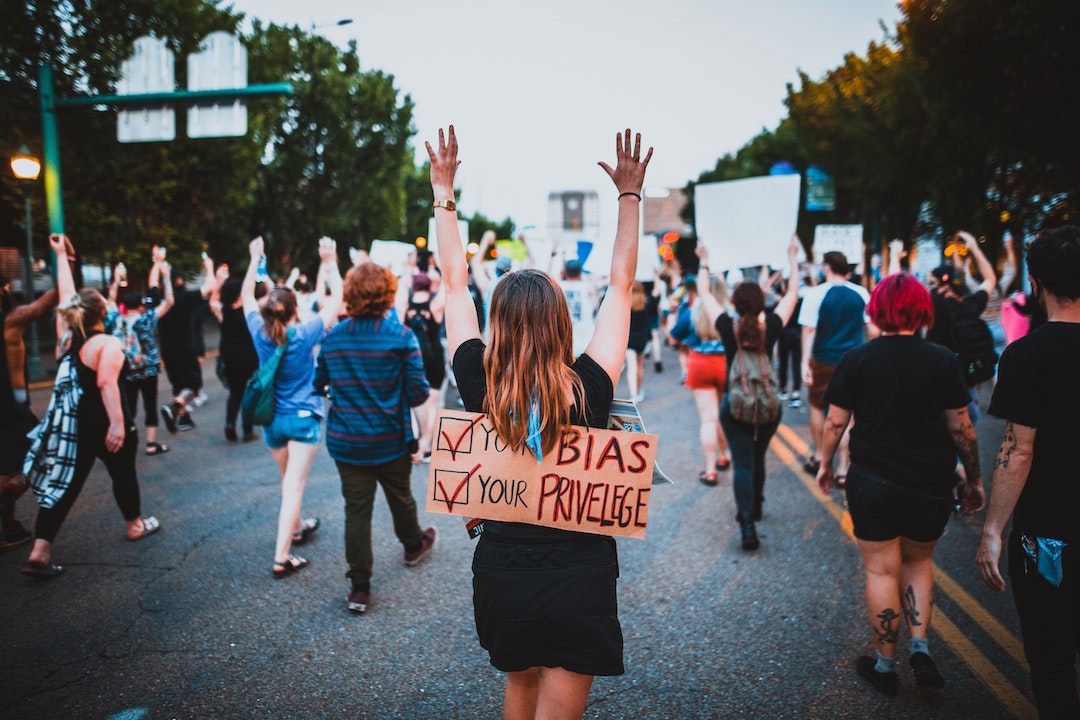By Tatyana Hopkins
George Washington University’s Program on Extremism (POE) has launched a database that records the arrests by federal and D.C. authorities of suspects connected to the Jan. 6 riots at the U.S. Capitol and tracks the cases’ movements through the court system—with nearly 100 suspects already in the database and hundreds more expected to be added.
“We want to document history and by any measure the Capitol Hill siege was a historic moment and a flashpoint of extremism in America, similar to what Waco and Ruby Ridge were,” said Seamus Hughes, POE deputy director.
He said the database, which is available to the public, informs the public about the nature of the threat of extremist violence in an accessible and non-alarmist way by allowing them to look at primary source court documents for themselves.
The GW tracker lists the names of each defendant, specific charges, case status, place of residency and court documents such as indictments, criminal complaints and requests for detention. Soon, it will also include transcripts of court proceedings.
“We'll keep monitoring every case as it goes through from beginning to end,” said Mr. Hughes. “Right now, they're all pending and going to detention hearings, but when they have to go to trial or plead guilty or are found guilty or innocent, we'll keep a record of that.”

As of Sunday, the site tracked and recorded 70 federal cases against individuals involved in the attack. Although individuals have been arrested in multiple states across the country, each of the cases in the database is being prosecuted by the U.S. Attorney’s Office for the District of Columbia.
The project is also tracking local District of Columbia cases related to the riot at the Capitol. To date, the page has published about two dozen cases of suspects charged by the Metropolitan Police Department in D.C.
“We’re going to focus most of our efforts on federal cases, and I think so will law enforcement,” Mr. Hughes said. “The ones that are charged at the D.C. level, the local level, tend to be folks that got arrested for things like loitering after curfew. I would be surprised if there’s any more D.C. level cases that come up.”
Since its launch six years ago, the POE has been committed to providing fact-based and nonpartisan analysis on the dynamics of extremism in the United States and abroad.
In the past year, the program continued work in its historical core topics concerning jihadist mobilization, particularly in the United States. Its research explored the financial dynamics of ISIS' American supporters, the effects of the COVID-19 pandemic on would-be jihadist travelers and efforts to repatriate accused American terrorists abroad. In June, through a collaboration with the New York Times, the program launched ISIS Files, a digital repository that provides public access to primary ISIS documents, as well as accompanying analytical reports that provide insight to into the Islamic State in Mosul, Iraq.
Meanwhile, POE also expanded its focus to the rising threat posed by racially and ethnically-motivated, as well as anti-government extremism in the United States. In 2020, the program provided research support to the Congressional Counter-Terrorism Caucus, which seeks to develop and adopt a comprehensive bipartisan framework to counter domestic terrorism. It also engaged policymakers through briefings and congressional testimonies about domestic extremism and radicalization.
The POE also co-authored a report with the Anti-Defamation League about the threat of white supremacist and neo-Nazi extremism, while staff authored articles about the need for a domestic terrorism statute, the Boogaloo movement’s activity in the United States and other issues.
For the Capitol Hill Siege Project, Mr. Hughes said the most important information collected has been the backgrounds of individuals charged and their affiliations with extremist groups, if any.
The latest analysis of the cases revealed that those suspected to be involved in the Capitol riots came from 25 states and the District of Columbia with an average age of 43. So far, cases have been bought against 63 men and seven women.
The documents also reveal a spectrum of alleged activity ranging from taking photos with the Capitol’s George Washington bust, destruction of property, theft, hitting police officers with fire extinguishers to planting bombs around the city.
Mr. Hughes said the documents also revealed a range of self-identified extremist activity.
“It’s all walks of life for extremism,” Mr. Hughes said. “There’s QAnon, white supremacists, Proud Boys, Boogaloos and, then, just the kind of average citizen drawn into this idea of ‘stop the steal’ the election. So, it’s been a bit of a hodgepodge of extremists.”
POE’s core team of three members rely on the online federal court records system to monitor for case developments as well as sources at the U.S. Department of Justice and other law enforcement agencies. They also have a network of journalists, many of whom POE trained on how to research and use court documents, who provide assistance.
“Extremism doesn't stop, and so, we’ve got other [POE] colleagues that are looking at ISIS and other colleagues that are looking at white supremacy in other areas of the country,” Mr. Hughes said. “We can't get all hands on this thing because the nature of extremism in America is such that it's busy everywhere.”
In light of heightened security at the U.S. Capitol due to President-Elect Joe Biden’s upcoming inauguration, Mr. Hughes warned about the threat of extremist activities around state capitals.
“You're not going to get the merely curious anymore,” he said. “You had a number of people who may have gotten swept up by the moment [on Jan. 6]. I think what’s going to be left on the 20th is going to be the true believers of extremism, and that may be more concerning for law enforcement because those are the folks that have been kind of waiting for this moment.”





